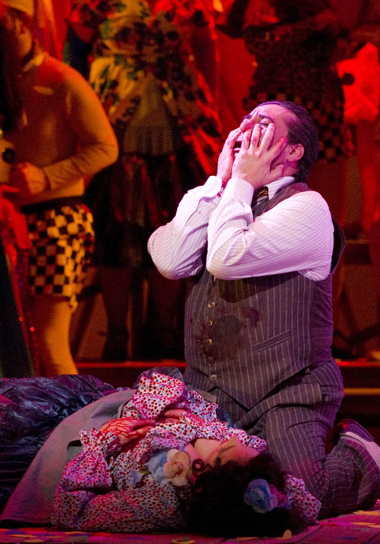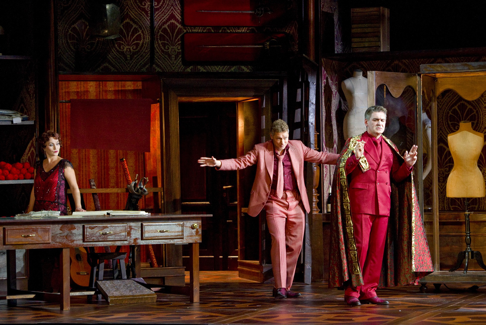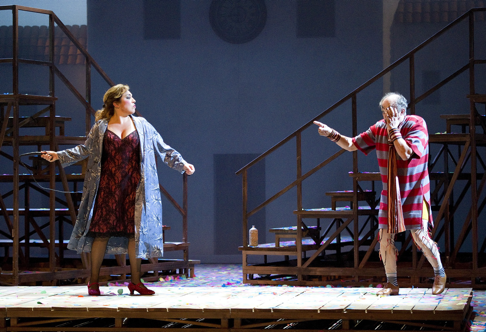
28 Feb 2015
Eine florentinische Tragödie and I pagliacci in Monte-Carlo
An evening of strange-bedfellow one-acts in high-concept stagings, mindbogglingly delightful.
English Touring Opera are delighted to announce a season of lyric monodramas to tour nationally from October to December. The season features music for solo singer and piano by Argento, Britten, Tippett and Shostakovich with a bold and inventive approach to making opera during social distancing.
This tenth of ten Live from London concerts was in fact a recorded live performance from California. It was no less enjoyable for that, and it was also uplifting to learn that this wasn’t in fact the ‘last’ LfL event that we will be able to enjoy, courtesy of VOCES8 and their fellow vocal ensembles (more below …).
Ever since Wigmore Hall announced their superb series of autumn concerts, all streamed live and available free of charge, I’d been looking forward to this song recital by Ian Bostridge and Imogen Cooper.
Although Stile Antico’s programme article for their Live from London recital introduced their selection from the many treasures of the English Renaissance in the context of the theological debates and upheavals of the Tudor and Elizabethan years, their performance was more evocative of private chamber music than of public liturgy.
Evidently, face masks don’t stifle appreciative “Bravo!”s. And, reducing audience numbers doesn’t lower the volume of such acclamations. For, the audience at Wigmore Hall gave soprano Elizabeth Llewellyn and pianist Simon Lepper a greatly deserved warm reception and hearty response following this lunchtime recital of late-Romantic song.
For this week’s Live from London vocal recital we moved from the home of VOCES8, St Anne and St Agnes in the City of London, to Kings Place, where The Sixteen - who have been associate artists at the venue for some time - presented a programme of music and words bound together by the theme of ‘reflection’.
'Such is your divine Disposation that both you excellently understand, and royally entertaine the Exercise of Musicke.’
‘And there was war in heaven: Michael and his angels fought against the dragon; and the dragon fought and his angels, And prevailed not; neither was their place found any more in heaven … that old serpent … Satan, which deceiveth the whole world: he was cast out into the earth, and his angels were cast out with him.’
There was never any doubt that the fifth of the twelve Met Stars Live in Concert broadcasts was going to be a palpably intense and vivid event, as well as a musically stunning and theatrically enervating experience.
‘Love’ was the theme for this Live from London performance by Apollo5. Given the complexity and diversity of that human emotion, and Apollo5’s reputation for versatility and diverse repertoire, ranging from Renaissance choral music to jazz, from contemporary classical works to popular song, it was no surprise that their programme spanned 500 years and several musical styles.
The Academy of St Martin in the Fields have titled their autumn series of eight concerts - which are taking place at 5pm and 7.30pm on two Saturdays each month at their home venue in Trafalgar Square, and being filmed for streaming the following Thursday - ‘re:connect’.
The London Symphony Orchestra opened their Autumn 2020 season with a homage to Oliver Knussen, who died at the age of 66 in July 2018. The programme traced a national musical lineage through the twentieth century, from Britten to Knussen, on to Mark-Anthony Turnage, and entwining the LSO and Rattle too.
With the Live from London digital vocal festival entering the second half of the series, the festival’s host, VOCES8, returned to their home at St Annes and St Agnes in the City of London to present a sequence of ‘Choral Dances’ - vocal music inspired by dance, embracing diverse genres from the Renaissance madrigal to swing jazz.
Just a few unison string wriggles from the opening of Mozart’s overture to Le nozze di Figaro are enough to make any opera-lover perch on the edge of their seat, in excited anticipation of the drama in music to come, so there could be no other curtain-raiser for this Gala Concert at the Royal Opera House, the latest instalment from ‘their House’ to ‘our houses’.
"Before the ending of the day, creator of all things, we pray that, with your accustomed mercy, you may watch over us."
The doors at The Metropolitan Opera will not open to live audiences until 2021 at the earliest, and the likelihood of normal operatic life resuming in cities around the world looks but a distant dream at present. But, while we may not be invited from our homes into the opera house for some time yet, with its free daily screenings of past productions and its pay-per-view Met Stars Live in Concert series, the Met continues to bring opera into our homes.
Music-making at this year’s Grange Festival Opera may have fallen silent in June and July, but the country house and extensive grounds of The Grange provided an ideal setting for a weekend of twelve specially conceived ‘promenade’ performances encompassing music and dance.
There’s a “slide of harmony” and “all the bones leave your body at that moment and you collapse to the floor, it’s so extraordinary.”
“Music for a while, shall all your cares beguile.”
The hum of bees rising from myriad scented blooms; gentle strains of birdsong; the cheerful chatter of picnickers beside a still lake; decorous thwacks of leather on willow; song and music floating through the warm evening air.

An evening of strange-bedfellow one-acts in high-concept stagings, mindbogglingly delightful.
These brief operas have interesting points of convergence, both are love triangles with older men and younger wives. both have physically unattractive protagonists, both are set in Italy. The librettos for both were written in the early 1890’s. And both are just plain ugly stories.
Nonetheless there are striking, irreconcilable differences that prevent them from creating a soul satisfying evening of opera. I pagliacci (1893) is one of the masterpieces of the startling new verismo movement in Italy. A Florentine Tragedy (1917) came 25 years later, captive of the psychological and musical complexities of the collapsing Viennese cultural hegemony. Simply said I pagliacci remains a fresh, new piece and A Florentine Tragedy rests a derivative attempt to revive lost musical enthusiasms. Namely and unabashedly the scandalous excitement created by Salome, Electra and Rosenkavalier.
 Barbara Haveman as Bianca, Carsten Wittmoser as Simone, Zoran Todorovich as Guido
Barbara Haveman as Bianca, Carsten Wittmoser as Simone, Zoran Todorovich as Guido
Zemlinsky’s rendering of Oscar Wilde’s sick little tale was simply Zemlinsky getting even with Gustav Mahler for being more attractive to Alma Mahler than he was. And, well, making an opera about Alma Mahler’s affair with the architect Walter Gropius while she was married to Mahler. It is a very personal, vindictive work.
It began the evening. When it was over the audience could not get to the bar fast enough.
Metteur en scène Daniel Benoin would have nothing to do with Zemlinsky’s monumental (triple or quadruple winds, six horns, huge percussion battery) pettiness and therefore set out to find a less gossipy context for this sordid tale. He moved the action from 16th century Florence to the Italy just a bit after 1917 and the emergence of Fascism. Simone (the older husband) exits his shop from time to time, passing the Black Shirt recruiters visible though the huge shop windows. For the dénouement he returns to his shop in full Blackshirt garb (he strangles young, old-order rich Guido). Simone and his young wife Bianca reconcile and the strong, new Italy is born!
The Zemlinsky opera is enormously enriched by this concept, given that Zemlinsky’s music does not really allow us to enter into the psyches of his actors (as, for example, Strauss had) but instead keeps us enthralled in the web of subterfuges Simone is creating to murder Guido. Director Benoin allowed that we might participate in politically powerful propaganda that can possibly be found in, or matched by the music rather than in the petty jealousies that are not musically supported.
The inherent irony of decadent music of a collapsing empire building a strong new political order did not trouble Mr. Benoin who was having fun with his designers. Set designer Rudy Sabounghi created a richly traditional Florentine shop, gorgeous in scope and detail, the exposition of luxury fabrics though was limited to sample books [!], but at last yards and yards of real fabric fell from the rafters, some of which Simone used to strangle Guido.
Nathalie Bérard-Benoin created costumes that were flagrantly and effectively at odds with the period details of the set, Simone in a monochrome rose modern suit, shirt and tie, Guido in a darker rose suit, shirt and tie. Bianca was in a Klimt inspired beaded dress and wigged firmly into the dying pre-fascist era.
It was a solid, sophisticated and amusing production richly conducted by Pinchas Steinberg who was unwilling to sacrifice the humors of Zemlinsky’s huge orchestrations when the singers were unable to sustain needed and appropriate volumes of sound. It was an orchestral, not a singerly event.
 María José Siri as Nedda, Leo Nucci as Tonio
María José Siri as Nedda, Leo Nucci as Tonio
The exact opposite may be said of I pagliacci. It was very nearly a dream cast of singers who kept the audience in their seats applauding long after Canio had slaughtered Nedda. The pagliacci were opera stars baritone Leo Nucci and the estimable tenor Marcelo Álvarez, the Nedda was Argentine soprano María José Siri who thrilled us with the shimmering edge to her youthful tone. Silvio was Chinese born, Covent Garden trained baritone Zhengzhong Zhou whose exceedingly beautiful voice made the love duet with Nedda a meltingly beautiful few minutes. Peppe was carefully and charmingly etched by Italian tenor Enrico Casari. While conductor Steinberg did not fully capture the intense dramas of verismo he did give these superb singers tempos on which its lyricism could gracefully soar.
In fact the lighter weight and easier movements of Leoncavallo’s vocal lines felt much more at home in tenor Álvarez‘ voice than does Puccini’s Cavaradossi, surely this excellent artist's signature role (recently sung at the Bastille). Baritone Leo Nucci is a nimble 72 years of age (he wanted us to know this by effecting a heel clicking jump now and again). He is in good voice and is still a viable Tonio. Soprano Siri, a Tosca in her own right (Vienna and Berlin), is young enough to be believable as a real Nedda and sufficiently experienced in the grand repertoire to bring real diva style to her portrayal.
The common element to both short operas was designer, Monaco native Rudy Sabounghi (director Benoin did his own lighting, Pagliacci was lighted by Laurant Castaingt). Sabounghi with Swiss metteur en scène Allex Aguilera had us see through the back wall of a stage in order to create the conceit that we too are the actors since we feel what they feel — I pagliacci plays very heavily with the metaphor of theater.
It got even more complicated. The pagliacci started out as circus clowns, drumming up business for the upcoming performance, their public were country folk on the way to church. Though by the time of the performance of the play within the opera Tonio and Canio had dressed themselves in everyday clothes as they were dealing with their real, off-stage passions. Conversely the country folk now had transformed themselves into commedia dell’arte costumes, like the actors on the stage should have been costumed. This audience then was seated on the stage directly mirroring the Salle Garnier audience, thus it was they who were dealing with theatrical passions. We, the Salle Garner audience, were dealing with the real passions. Verismo indeed.
It all more or less worked in its weird way. Most of all it gave us something to get our minds around. Neither of the stagings found the essences of these strange little operas, nor were they looking for the them. It was a high-level, challenging and ultimately satisfying evening of opera.
Michael Milenski
Casts and production information:
A Florentine Tragedy Guido Bardi: Zoran Todorovich; Simone: Carsten Wittmoser; Bianca: Barbara Haveman. Mise en scène et lumières: Daniel Benoin; Décors: Rudy Sabounghi; Costumes: Nathalie Bérard-Benoin. I pagliacci Canio: Marcelo Álvarez; Nedda: María José Siri; Tonio: Leo Nucci; Beppe: Enrico Casari; Silvio: ZhengZhong Zhou. Mise en scène: Allex Aguilera; Décors Rudy Sabounghi; Costumes: Jorge Jara; Lumières: Laurent Castaingt. Chorus of the Opéra de Monte-Carlo, Orchestre Philharmonique de Monte-Carlo. Conductor: Pinchas Steinberg. Salle Garnier, Monte-Carlo, Monaco, February 25, 2015.